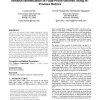Free Online Productivity Tools
i2Speak
i2Symbol
i2OCR
iTex2Img
iWeb2Print
iWeb2Shot
i2Type
iPdf2Split
iPdf2Merge
i2Bopomofo
i2Arabic
i2Style
i2Image
i2PDF
iLatex2Rtf
Sci2ools
ESEM
2008
ACM
2008
ACM
Iterative identification of fault-prone binaries using in-process metrics
Code churn, the amount of code change taking place within a software unit over time, has been correlated with fault-proneness in software systems. We investigate the use of code churn and static metrics collected at regular time intervals during the development cycle to predict faults in an iterative, in-process manner. We collected 159 churn and structure metrics from six, four-month snapshots of a 1 million LOC Microsoft product. The number of software faults fixed during each period is recorded per binary module. Using stepwise logistic regression, we create a prediction model to identify fault-prone binaries using three parameters: code churn (the number of new and changed blocks); class Fan In and class Fan Out (normalized by lines of code). The iteratively-built model is 80.0% accurate at predicting faultprone and non-fault-prone binaries. These fault-prediction models have the advantage of allowing the engineers to observe how their fault-prediction profile evolves over time. C...
| Added | 19 Oct 2010 |
| Updated | 19 Oct 2010 |
| Type | Conference |
| Year | 2008 |
| Where | ESEM |
| Authors | Lucas Layman, Gunnar Kudrjavets, Nachiappan Nagappan |
Comments (0)

